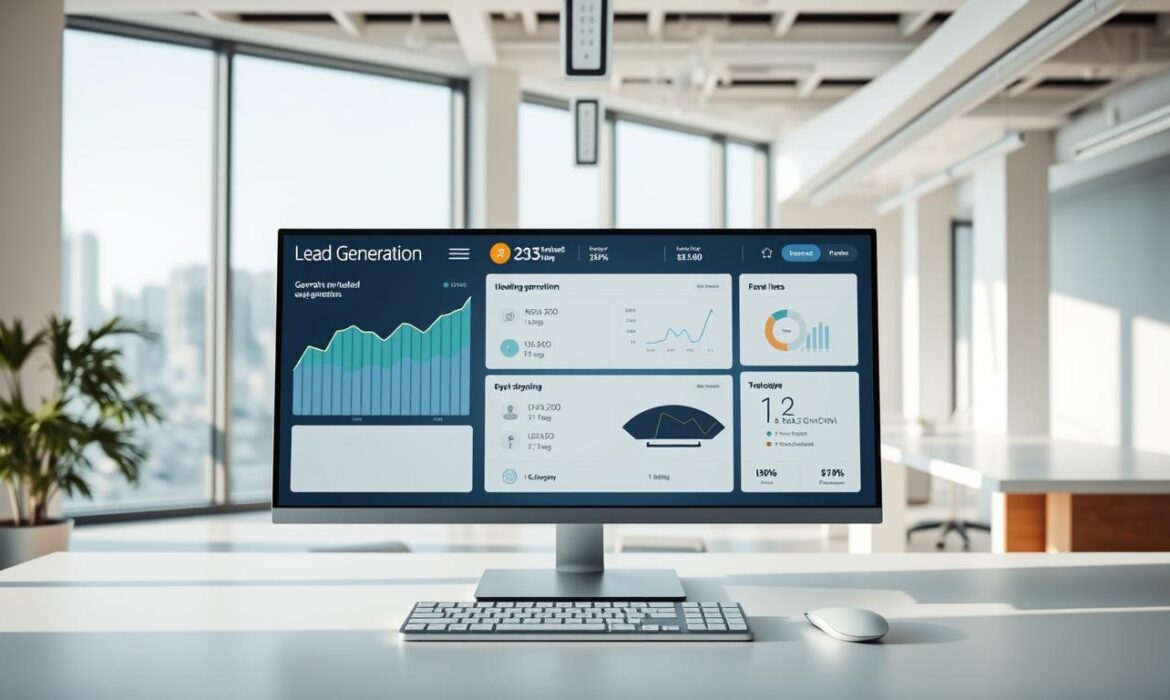
Did you know 64% of marketers use AI and automation to get better leads? This shows how companies are quickly adopting automated lead generation. They want to cut down on manual work and reach more people.
Automated lead generation lets your team focus on more important tasks. It makes the sales process easier and more efficient. By automating lead generation, you can build stronger relationships and increase conversions.
Marketing automation lead strategies help you keep track of prospects. You can engage them with content that matters to them. This keeps your business growing.
Understanding the Value of a Robust Lead Management System
In today’s campaigns, a solid system keeps your pipeline in order. It combines lead management with tools like email and chatbots. Every interaction is tracked, making it clear how leads become customers.
This setup means you can handle more leads with less effort. It boosts productivity without losing the personal touch.
Companies that use a lead generation process stand out. They smoothly move contacts through the system, scoring and prioritizing them. This keeps sales and marketing in sync, guiding leads to the right services at the right time.
An integrated platform also includes marketing automation for lead generation. It creates personalized campaigns that speak to each prospect’s needs. This turns interest into action, building trust and moving prospects through the funnel.
Teams can use marketing automation to handle repetitive tasks. This makes outreach consistent and helps with growth. Sales managers and marketers get clear dashboards, ensuring no opportunity is missed.
Popular platforms offer these features:
| Platform | Key Feature |
|---|---|
| HubSpot | Unified CRM and email |
| Salesforce | Advanced third-party integrations |
| Marketo | Comprehensive analytics |
Key Advantages of Lead Generation Automation
Modern businesses get big benefits from using advanced lead generation strategies. It makes tasks less repetitive, letting marketers focus on creative work. Tools like Mailchimp, Leadfeeder, and Marketo offer insights for better lead nurturing.
Companies using automated lead generation software see better conversion rates. They can manage leads across different platforms, giving a smooth experience to potential customers. This leads to quicker responses and stronger early interest.
- Boosts overall productivity
- Enhances lead nurturing
- Reduces manual errors
This leads to smarter marketing choices. Team members can work on personalized chats or impactful pitches. This results in more meaningful engagement and loyalty.
Driving Efficiency Through Automated Lead Management
Teams get a system that handles contact scoring and lead segmentation. With automation, sales reps can build trust. This often leads to stronger relationships and higher sales.
Streamlining Outreach with Marketing Automation
Outreach becomes easier with the right timing for each lead. Automatic lead generation schedules touchpoints and sends personalized messages. A well-planned approach keeps prospects engaged, making them more likely to become loyal customers.
How Automated Lead Generation Empowers Marketing Teams
At the heart of today’s marketing is auto lead generation. It changes how teams work by cutting out boring tasks and giving insights quicker. Marketers can sort prospects by common interests and craft campaigns that speak to each group.
Marketing automation and lead generation make messages personal, so the right offers reach the right people. With lead gen automation, teams can focus on creativity without losing quality. They improve strategies with real-time data, making every message more relevant and timely.
“Automation is the future,” noted a leading marketing strategist from HubSpot. “Teams can scale campaigns with less human intervention when platforms handle the heavy lifting.”
Using leads automation lets marketers dive into big ideas, not just routine tasks. This strengthens connections with prospects and makes every message feel personal. Over time, it builds trust and boosts responses in the pipeline.
Building an Effective Lead Generation Workflow
Starting to find potential buyers involves clear steps. These steps help move people from just showing interest to really getting involved.
Teams do best when they automate leads at key moments. This way, they can follow up right away and keep things moving.

Structuring the Lead Capture Process
Companies often get automated leads through landing pages, web forms, and direct messages. A good capture method gets the right info quickly. This might include name, email, and what they’re struggling with.
Salesforce or other CRM platforms can then sort these leads for quick follow-ups.
Integrating Automated Lead Generation Software
Strong systems manage leads automatically and work with other tools and channels. This setup ensures everyone knows what’s happening with each lead. Lead automation tools keep track of everything and tell teams what to do next.
Using these tools means staff can focus more on building trust. They won’t be bogged down by manual tasks. This leads to a smoother workflow and growth.
Enhancing Your Sales Funnel with Lead Generation and Marketing Automation
Many companies grow a lot when they use a lead generation marketing automation tool. They also focus on sending messages that really speak to people. Studies show that targeted campaigns can make people more engaged and build stronger connections.
Tools like Marketo, HubSpot, and Leadfeeder make lead nurturing more precise. They help increase conversion rates by sending messages at the right time.
Marketing automation lead generation software makes the journey from interest to decision clearer. It shows which messages work best and guides the process with better insights. An auto lead generator finds the perfect time to reach out, boosting engagement and moving leads forward.
Nurturing Prospects into Qualified Leads
Teaching potential buyers is crucial. Use whitepapers, tutorials, and timely follow-ups to keep them informed. Sales lead automation flags leads for targeted outreach, turning them into active participants.
Closing More Deals with Auto Lead Generation Techniques
Seeing each prospect’s journey helps teams focus on the best opportunities. Small changes in timing or message can make hesitant leads more likely to buy. With the right tools, businesses can build stronger relationships and grow for the long term.
Leveraging Outbound Leads Scraping Tools for Consistent Growth
Companies find new ways to make money by looking for potential clients on other platforms. Outbound leads scraping tools search for new leads on social networks, industry sites, and partner directories. They then add these leads to the company’s CRM system.
This method finds contacts that might not be found through other ways. It helps companies reach out to people who are likely to be interested in their products or services.
Many businesses use lead automation software to check if leads are good. Tools like automated LinkedIn lead generation find the right people to talk to. They look for decision-makers with the right job titles and company sizes.
Once leads are found, they are sorted based on location or budget. This makes follow-up more effective and increases success rates.
Sales teams often ask about the third step in automating prospecting. This step is about making outreach personal. It involves customizing messages to fit each lead’s preferences.
By using marketing automation for lead management, companies can give each lead personal attention. This approach leads to higher conversion rates, builds trust, and increases brand loyalty over time.
Overcoming Common Obstacles in Automating Lead Generation
Many businesses struggle when they try to grow their processes. Issues like data errors and platforms that don’t talk to each other can slow things down. But, with the right tools and focus, these problems can be solved.
Addressing Data Quality and Validation
A good outbound leads scraping tool can fill your pipeline fast. But, bad data can waste a lot of time. It’s smart to check and validate data regularly.
This keeps your marketing automation lead management on track. It makes sure the right leads move forward and finds weak contacts early.
Ensuring Seamless Integration with Existing Systems
It’s crucial to have software that works well with your CRM. If it doesn’t, your lead management plans won’t work. Better integration means less confusion and better results.
By making sure your systems work together well, you can run smoothly from start to finish.
| Obstacle | Strategy |
|---|---|
| Poor Data Hygiene | Apply frequent validation checks |
| System Incompatibility | Use open APIs for frictionless connections |
Strategies to Automate Lead Follow Up and Increase Conversions
Personalized messages can really stand out in a crowded inbox. Studies show that targeted emails and ads can increase open rates and sales. With the help of automatic lead tools, teams can focus on more meaningful conversations.
Start by addressing people by their names and tailoring messages to their interests. Using fresh information about them can grab their attention. This way, you avoid the common myth that follow-up is boring. Instead, it encourages potential buyers to take action.
Personalization Tactics for Higher Engagement
Using software that combines lead scraping with smart segmentation helps you reach the right people. Automation lets your team focus on complex questions while handling routine tasks. This approach builds trust and moves prospects closer to making a purchase.
- Segment audiences by behavioral data
- Design drip campaigns with targeted offers
- Measure open and reply rates for tweaks
| Strategy | Outcome |
|---|---|
| Customized Emails | Higher Reply Rates |
| Live Chatbots | On-Demand Assistance |
| Timed Retargeting Ads | Renewed Brand Awareness |
These strategies make every interaction more effective. Prospects feel valued, leading to repeat business and a positive image of your brand. You might see shorter sales cycles and stronger customer loyalty. A well-timed, personalized message can turn a casual browser into a loyal customer.
Aligning Sales and Marketing for Lead Management Automation
Sales and marketing work best when they share a goal. They focus on lead generation together, leading to better teamwork. They use tools like linkedin lead generation automation to find prospects quickly.
Unifying Campaign Goals and Metrics
Having the same goals makes progress clear. Marketing might aim for brand awareness, while sales targets revenue. It sales lead generation platforms help track progress in real time.
A unified plan means no surprises. It tells exactly when to pass leads to sales.
Collaborating on Automated Lead Workflows
Good communication is key in sales lead generation. Marketing crafts the message early on, then alerts sales when leads qualify. This teamwork boosts conversions in the lead generation workflow.
Both teams stay aligned, and customers get a smooth experience at every touchpoint.
The Role of Lead Automation in Long-Term Business Scalability
Businesses often look for ways to grow when they enter new markets or launch new products. They might feel like they’re stretched thin. A smart move is to focus on each lead generation task that fills your pipeline. This way, you don’t miss out on chances and can grow.

When more people reach out, a solid lead gen process is key. It ensures quick responses without overloading your team. Automated lead follow up then keeps the conversation going. This keeps people interested and helps build stronger relationships later on.
A strong system is crucial for growing your brand. The b2b lead generation process takes longer because of the bigger decisions involved. Consistent contact and nurturing keep potential clients engaged. Lead automation helps by handling the details, saving you time and energy.
| Key Element | Primary Benefit |
|---|---|
| Centralized Lead Management | Enables swift responses and streamlines tasks |
| Performance Tracking | Identifies effective strategies for steady expansion |
| Ongoing Nurturing | Builds trust with leads throughout their buying journey |
Conclusion
An automated lead generation system does more than just collect names. It grows, making the journey from inquiry to loyal client smoother. By combining lead generation and marketing automation, your team gets a flexible system that adapts to new needs.
Marketing automation tools help you reach more people and be more precise. Automating lead generation makes your team more efficient while still being personal. This is true for all industries, including IT, where building trust is key.
Improvements in data collection help you react quickly to market changes. With the right plan, each lead becomes a valuable partner. This growth boosts sales and makes your business stronger.




